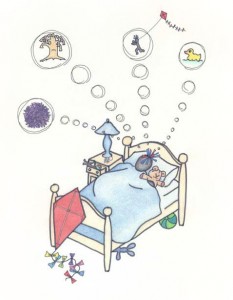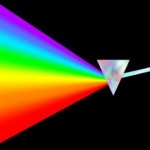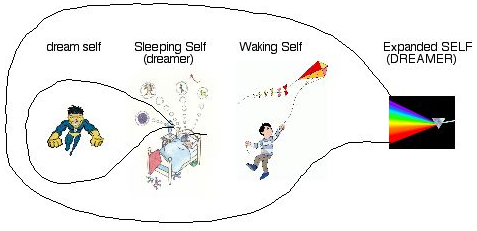“Could You Be Dreaming Now?”
“Could You Be Dreaming Now?”
by Beverly (Kedzierski Heart) D’Urso, Ph.D. Copyright © 2011
Presentation for the 2011
International Association for the Study of Dreaming
PsiberDreaming Conference
Do you tend to label the ‘waking’ state as distinct from the ‘dreaming’ state? What if you actually ‘dream’ while in the waking state? Try referring to everything you ever experience as ‘dreaming,’ and deciding that your experiences differ only in your level of lucidity. You could then continuously apply lucidity techniques and lessons from sleeping lucid dreams to enhance your life. In this session, you will examine your current level of lucidity, which could lead to discovering a new aspect of yourself and new way to view your world.
Research on lucid dreaming shows that brain waves during REM sleep, the state in which you often dream, look remarkably like waking state brain waves. Tests can show whether or not you are sleeping, and if you are dreaming while sleeping, but not necessarily that you only dream in the sleeping state. Therefore, consider this theory of why you dream: You have the capability and need to dream in the sleeping state, in order to help you remember that you dream in the waking state. In a sleeping dream, it appears that your physical self, an expanded self you can call the ‘dreamer,’ dreams up your dream self. In a similar manner in the waking state, you might actually get dreamed up by an expanded SELF, which you can call the DREAMER of your life. You may actually exist as an aspect of the DREAMER, just as in the sleeping state your dream self exists as an aspect of you, the dreamer. This DREAMER produces the drama in your life and creates your world, which you can call a ‘dream.’
If you want to have a sleeping state lucid dream, you might practice answering the question, “Could you be dreaming now?” in the waking state so that your dream self would eventually answer it while you were asleep and dreaming. Your dream self might respond in the positive, expand consciousness, and get lucid, while you remain in the sleeping state. In other words, your dream self expands into the dreamer, and you know you are dreaming in the sleeping state, the actual definition of lucid dreaming.
In a similar way in the waking state, if you answer the question at least partially in the positive, you would expand consciousness and get lucid while you remain in the waking state. In this case, you have expanded into the DREAMER, and YOU know that YOU are dreaming in the waking state. This is also called lucid living (D’Urso, 2007).
Some Eastern religions, as well as Western philosophies, focus on the ‘negative’ aspects of seeing life as a dream, such as illusion or projection. (See APPENDIX A: The Dream Argument.) These are comparing life to non-lucid dreaming. This session looks at the ‘positive’ aspects of seeing life as a dream by concentrating on lucid dreaming. When lucid in the waking state, YOU experience YOURSELF as a producer of YOUR life instead of as a mere character. Just as in sleeping lucid dreams, YOU can get more lucid and move through ‘blocks’ that seem to restrict YOU in YOUR waking state. Flying through walls in a sleeping lucid dream, and discovering the power that you lost as a child in your waking lucid dream, both demonstrate ‘moving through a block.’
How do you become lucid in your waking state? You can use the ways you become more lucid in the sleeping state (D’Urso, 2007). For example, (1) practice becoming more aware or present and look for unusual situations; (2) answer the question, “Could you be dreaming now?”; (3) review recurring scenarios; (4) record, share, and study your life/dreams; (5) set lucidity goals; and (6) ‘act as if’ you are dreaming. This last technique does not mean to take unnecessary risks. Merely consider what might seem possible, and how YOU might act and respond, if YOU were dreaming. (See Appendix B: Beverly’s personal examples of lucidity in the waking state.)
Practice becoming more aware, not only of what your senses take in of your surroundings, such as sights and sounds, but of your body sensations and energies. You can notice lucidity as a very deep sensation, especially if your mind seems clear and lacks a continuous stream of thoughts involving the past and the future. In other words, experience presence. You can help clear your mind by practicing meditation, or by sensing your arms and legs instead of focusing on your head (Almaas, 2008).
Most importantly, answer the question as often as possible: “Could you be dreaming now?” with awareness of what this might imply. This question gets asked by the dreamer, your physical self, in the sleeping state and by the DREAMER, your expanded SELF, in the waking state. In effect, in both states, you are being asked if you are being dreamed up right now. Merely questioning if you are dreaming, in the sleeping state or the waking state, can get you to a certain level of lucidity. Remaining open to the possibility that you are dreaming brings you to yet another level. Remember, contrary to many beliefs, you do not need to ‘control’ your dream for it to have lucidity. The appearance of control only shows that the level of lucidity has changed. At some levels, you may not even experience a body nor an environment, and yet come back to a place of amazing peace, strength, and joy (D’Urso, 2009).
So, “Could you be dreaming now?”
If you feel certain that you know you are not dreaming, you might miss out on experiencing the exhilarating, creative, and potent ‘magic’ that lucid dreaming can bring to every moment. See if your answer changes if you ask, “Could an expanded SELF be dreaming you up right now?” Can you see how these two questions relate? Do you label people who do not know they are not dreaming as crazy, or do you view people who know they are not dreaming as more sane? When did you first learn the concept of ‘dreaming’ or of being ‘awake’? Why do you need to see them as mutually exclusive? When you think you know you are not dreaming, do you sense that you have little control or total control over your life? Do you see unlimited possibilities in your life or do you believe that some things are impossible? Do you view yourself as a separate individual without connection to others or do you really sense the oneness of everything? Do you believe that you exist only as your body or do you sense yourself as more than this?
If you do not know for sure that you are dreaming, in other words you only have a belief that you are dreaming, you could say that you have some, but not much, lucidity. If you act dangerously upon this belief, you could experience  disaster. For example, you could feel the pain of broken bones from jumping off a cliff in the sleeping state or in the waking state. This accounts for people that you may have heard of who perform dangerous actions because they thought they were dreaming, but did not know for sure. If you remain aware and sense your body, you’ll find many ways to help you determine that you are dreaming. Until you know for sure, however, don’t take unnecessary risks!
disaster. For example, you could feel the pain of broken bones from jumping off a cliff in the sleeping state or in the waking state. This accounts for people that you may have heard of who perform dangerous actions because they thought they were dreaming, but did not know for sure. If you remain aware and sense your body, you’ll find many ways to help you determine that you are dreaming. Until you know for sure, however, don’t take unnecessary risks!
If you do not know for sure that you are not dreaming – if, in other words, you remain open to the possibility that you are dreaming – you have the potential for the ‘magic’ of lucidity while awake or asleep! So, stay with the question: “Could you be dreaming now?” What comes to mind? Have you noticed that you often repeat patterns from earlier in life over and over again like a recurring nightmare? If you were dreaming now, do you automatically think that the world around you would look fuzzy or more clear than if you were not dreaming? What would you do or not do? Would you feel more or less safe if you were dreaming or not dreaming?
If you know that you are dreaming, in the sleeping or the waking state, you can have amazing adventures and even get to a place of self-realization. The possibilities seem endless! At a certain stage of lucid dreaming, you might view having adventures in your lucid dreams as the primary purpose of lucid dreaming. For example, in a lucid dream of any state, you might start with asking yourself what you’d like to do next. Perhaps you have a goal in mind. You might ignore other possibilities, such as allowing yourself the sense of freedom and joy that you really want from the goal in the first place. While attempting your goal, you might get sidetracked. You might forget that you are dreaming, and decide that you don’t have the power to attempt the goal after all. Something might seem to block you, and you might judge the goal as impossible. With more lucidity, however, you can eventually discover your inner strength, as well as understand the block.
To take lucid dreaming to a further stage, instead of focusing on adventures and goals, look at the implications of what it means to know you are dreaming, or that you are being dreamed up, right now. In a lucid life, as in sleeping lucid dreams: (1) YOU can ‘control’ YOUR life to some degree, but only because of YOUR expansion into the DREAMER. In a sense, the DREAMER can guide YOU if you don’t resist. (2) Seemingly impossible experiences can occur in YOUR waking state. YOU might experience extreme synchronicities, awesome psychic abilities, or amazing powers of strength or will. Think about the reported abilities of Jesus Christ, such as raising the dead and getting resurrected. Could his level of lucidity and his expansion into the DREAMER have something to do with his abilities? (3) YOU can sense YOUR oneness or connection with everything and everyone in YOUR life when YOU see each as an aspect of the DREAMER. (4) YOU can know YOURSELF as more than just YOUR physical body. Waking up out of a sleeping dream could even suggest that one day you might wake up out of your life. What do you think this implies?
Scientists say that while sleeping, you often experience dreams, usually in REM sleep, even though you may not remember them. They also show that you go into deep, non-REM sleep, as well. Apparently, you don’t usually dream in this deep state, and therefore you don’t really experience it. Your sleeping physical self dreams and then doesn’t dream, back and forth continuously. Therefore, by implication, the DREAMER may do the same, periodically manifesting life. Many human-developed systems do this as well. Computer programs ultimately work using an alternating series of 1’s and 0’s. Circuit boards have resistors that allow, and then don’t allow, electric flow. Could this on/off process explain how manifestation actually works? Studies that restrict REM sleep show that you do best in the waking state when, in the sleeping state, you have REM periods where you can dream and manifest worlds, even if you don’t remember doing so. Do you think the DREAMER does best by periodically manifesting life?
In conclusion, stay aware of your experiences; meaning your thoughts, feelings, sensations, and energies, in both the sleeping state and the waking state. Do not resist nor deny them even if they seem uncomfortable. Ask yourself if you have noticed these before. Understand where they come from (Almaas, 2008). Then, from a place of more lucidity, answer the question again: “Could YOU be dreaming now?” and “What does YOUR answer imply?”
APPENDIX A: The Dream Argument (from Wikipedia)
http://en.wikipedia.org/wiki/Dream_argument
While people dream, they usually do not realize they are dreaming (if they do, it is called a lucid dream). This has led philosophers to wonder whether one could actually be dreaming constantly, instead of being in waking reality (or at least that one can’t be certain that he or she is not dreaming). In the West, this philosophical puzzle was referred to by Plato (Theaetetus 158b-d) and Aristotle (Metaphysics 1011a6). Having received serious attention in René Descartes‘ Meditations on First Philosophy, the dream argument has become one of the most prominent skeptical hypotheses.
In the East, this type of argument is well known as “Zhuangzi dreamed he was a butterfly” (369 BC)…This was a metaphor for what he referred to as a “great dream”: …Confucius and you are both dreaming! And when I say you are dreaming, I am dreaming, too. Words like these will be labeled the Supreme Swindle. Yet, after ten thousand generations, a great sage may appear who will know their meaning, and it will still be as though he appeared with astonishing speed.
APPENDIX B: Beverly’s personal examples of lucidity in the waking state
A great example of using a lucidity technique in my waking life occurred when I noticed recurring scenarios of an argument during my romantic relationships before I got married. The last time this scenario occurred, I suddenly thought, “This seems like a recurring theme” and “Could you be dreaming now?” I immediately saw my partner as an aspect of the DREAMER, and considered his point of view and what he had to teach me. With trust and surrender, I stayed present. Exactly as the witches did in my childhood nightmares when I faced up to them, my partner froze, stopped yelling, and then turned and walked away. I no longer needed to play out this drama and have not done so in the past twenty years.
I also acted with lucidity in my waking life when I set a goal of having a family. Acting as if I was dreaming, I believed in miracles instead of the terrible odds of having a family in my forties. I now have been married for eighteen years and we have a sixteen year-old son.
Often, I see how I block myself by reacting to my strong emotions, instead of just feeling and understanding them (D’Urso, 2010). When I stay present, and in the flow of what is happening without resistance, more possibilities eventually seem to open up. I also find myself guided to what I could easily have missed: unusual situations ranging from finding perfect airplane reservations to noticing precognition. I share these with others on a daily basis.
REFERENCES
D’Urso, B. (2007). Lucid dreaming: A bridge to lucid living. Workshop, International Association for the Study of Dreams (IASD) Conference. Sonoma, CA.
http://durso.org/beverly/IASD_Workshop_2007.html
Almaas, A. H. (2008). The unfolding now: Realizing your true nature through the practice of presence. Boston. MA: Shambhala Publications.
http://ahalmaas.com/Books/unfolding_now.html
D’Urso, B. (2009). Levels of consciousness and lucidity while dreaming or awake. Presentation, International Association for the Study of Dreams (IASD) PsiberDreaming Conference. Online.
D’Urso, B. (2010). Emotions in dreams lead to self-realization. Presentation, International Association for the Study of Dreams (IASD) PsiberDreaming Conference. Online.




